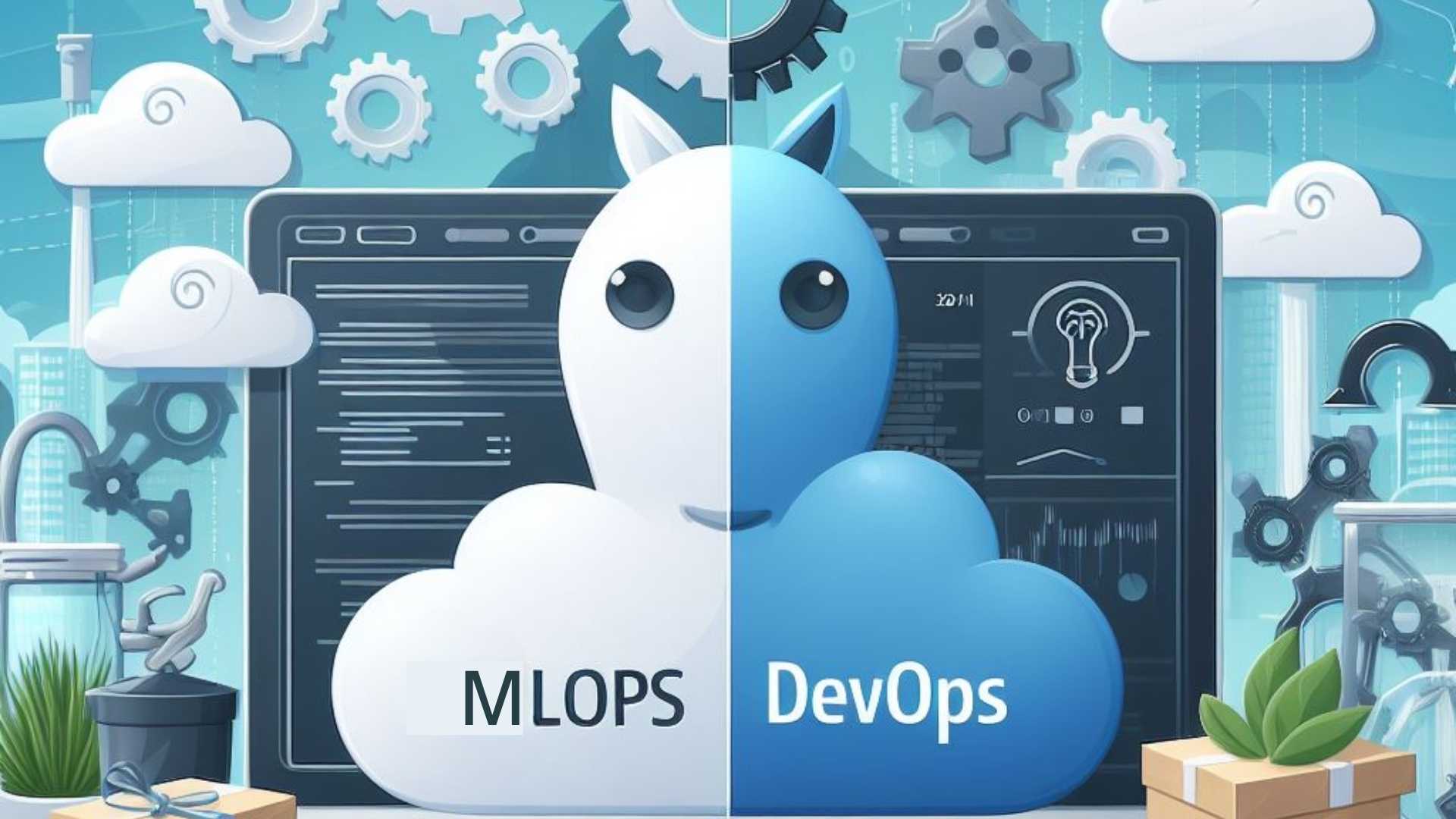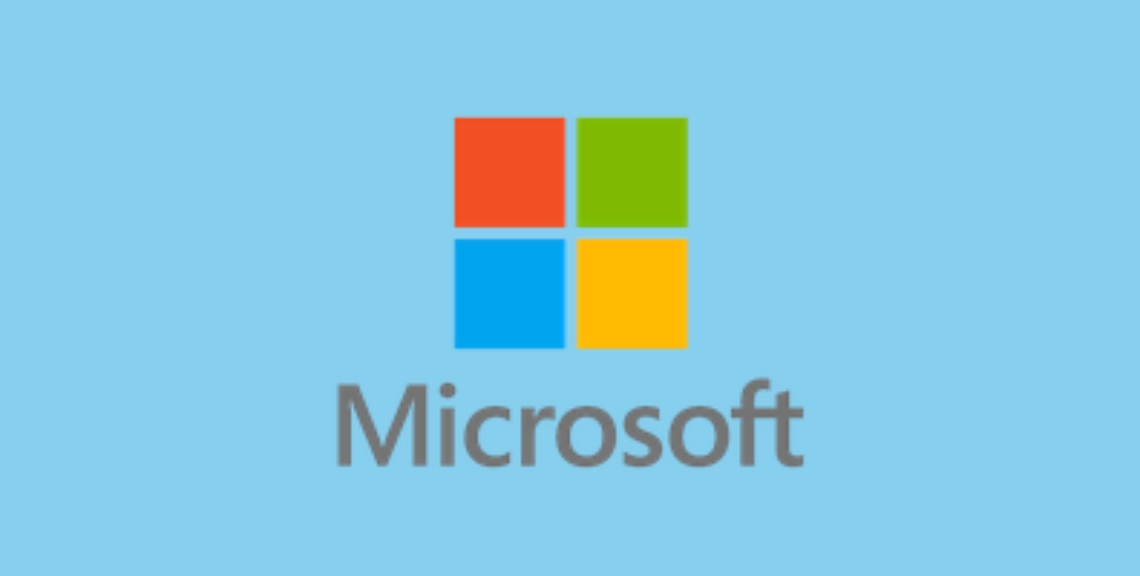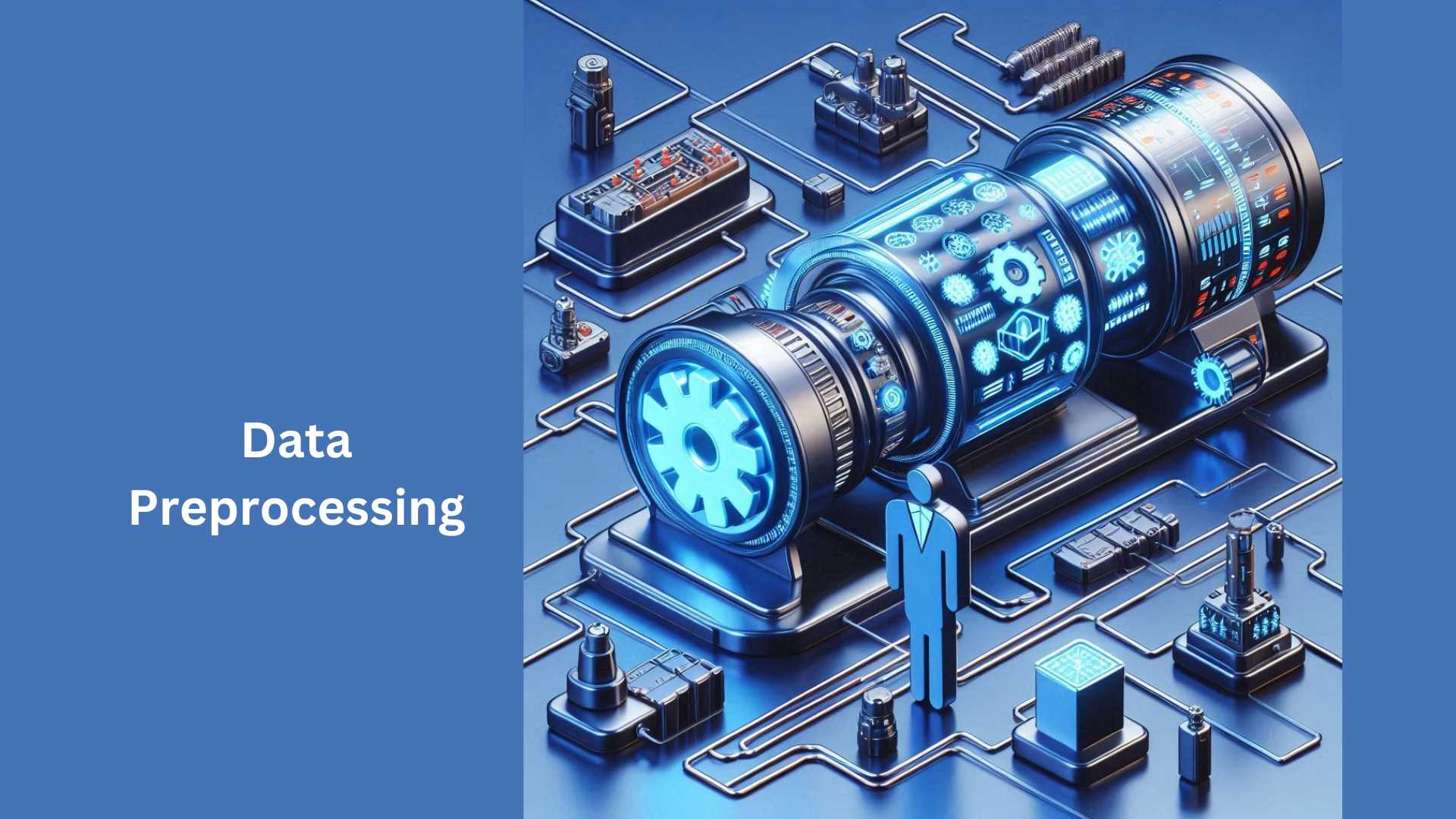MLOps vs DevOps, though sharing similarities in name and concept, address different facets of the software development lifecycle. DevOps emphasizes collaboration between development and IT operations to streamline the delivery of conventional software applications. In contrast, MLOps is tailored to meet the unique requirements of machine learning (ML) projects.
MLOps vs DevOps: Optimizing development in distinct realms
Both MLOps vs DevOps emphasize automation and streamlined workflows. However, the heart of their differences lies in their focus. MLOps tackles the unique challenges of developing, deploying, and monitoring ML models. This includes tasks like data management, model versioning, and performance monitoring in production. DevOps, in contrast, prioritizes application performance, reliability, and continuous delivery pipelines for traditional software development.
While their areas of expertise differ, MLOps and DevOps share some core principles. Both leverage automation tools and infrastructure-as-code (IaC) to build robust and repeatable workflows. They also promote collaboration between development and operations teams, ensuring a smooth transition from development to production. Understanding these distinctions between MLOps vs DevOps is crucial for organizations looking to optimize their software development processes, be it traditional applications or cutting-edge ML models.
Introduction to MLOps and DevOps
What are MLOps and DevOps?
DevOps and MLOps are methodologies designed to streamline and optimize the development, deployment, and management of software systems.
DevOps emphasizes integrating development (Dev) and operations (Ops) teams to enhance collaboration and automate processes throughout the software development lifecycle. It focuses on practices, tools, and cultural philosophies that facilitate seamless transitions from planning and coding to testing, deployment, and monitoring.
MLOps extends this concept to machine learning (ML) systems, ensuring their efficient deployment and management. It incorporates similar principles of collaboration, automation, and integration but tailors them to the unique requirements of ML development and deployment. MLOps manage ML models throughout their lifecycle, from data preparation and model training to deployment, monitoring, and continuous improvement.
Importance of MLOps and DevOps in modern software development
- Agility: MLOps and DevOps facilitate agility in modern software development by streamlining processes and reducing bottlenecks.
- Through automation and collaboration, teams can quickly respond to changing requirements and market demands.
- Reliability: By promoting continuous integration and delivery (CI/CD), MLOps and DevOps ensure the reliability of software products.
- Automated testing and deployment pipelines minimize errors and inconsistencies, leading to more dependable software systems.
- Scalability: The scalability of software solutions is greatly enhanced through MLOps and DevOps practices.
- Automated scaling mechanisms and infrastructure as code (IaC) allow for seamless expansion of resources, accommodating growing user bases and increasing workloads without compromising performance.
- Automation: Both MLOps and DevOps emphasize automation throughout the software development lifecycle.
- This reduces manual interventions, speeds up repetitive tasks, and frees up valuable human resources to focus on innovation and problem-solving.
- Continuous Integration and Delivery (CI/CD): CI/CD pipelines ensure the rapid and reliable delivery of software updates and features.
- By automating build, test, and deployment processes, MLOps and DevOps enable frequent releases, keeping pace with market demands and user feedback.
- Collaboration Among Teams: MLOps and DevOps foster collaboration among development, operations, and data science teams.
- By breaking down silos and promoting cross-functional communication, they enable smoother workflows and faster problem resolution.
- Speed of Development: With automation, standardized processes, and collaborative environments, MLOps and DevOps accelerate the speed of software development.
- This agility allows organizations to iterate quickly, experiment with new ideas, and stay ahead of competitors.
- Error Reduction: Through automated testing, monitoring, and deployment, MLOps and DevOps minimize the occurrence of errors in software products.
- By catching issues early in the development cycle and facilitating rapid fixes, they contribute to higher quality and more robust applications.
- Adaptation to Changing Requirements: The flexible nature of MLOps and DevOps methodologies enables organizations to adapt swiftly to changing requirements and market conditions.
- Continuous feedback loops and iterative development cycles ensure that software remains aligned with evolving business needs and user expectations.
- Improvement in Quality and Efficiency: Overall, MLOps and DevOps lead to improvements in the quality and efficiency of software development processes.
- By promoting best practices, fostering collaboration, and leveraging automation, they enable organizations to deliver higher-quality software products more efficiently and reliably.
What Is MLOps?
MLOps, short for Machine Learning Operations, refers to the practices, tools, and principles aimed at operationalizing and managing machine learning models throughout their lifecycle, from development to deployment and monitoring. It encompasses aspects of development, deployment, monitoring, and governance specific to ML systems.
Components and principles of MLOps
Key Components:
- Data Preparation: This involves collecting, cleaning, and transforming data to make it suitable for training machine learning models.
- Model Training: It encompasses the process of building and refining machine learning models using algorithms and training data.
- Model Deployment: After training, models need to be deployed to production environments where they can be accessed by users or other systems.
- Monitoring: Continuous monitoring of deployed models is crucial to ensure their performance remains optimal and to detect any issues or deviations.
- Feedback Loops: Feedback loops enable the integration of user feedback and new data into the model training process, allowing for iterative improvements.
Guiding Principles:
- Reproducibility: MLOps aims to ensure that model development and deployment processes are reproducible, enabling consistent results across different environments.
- Scalability: MLOps systems should be designed to handle increasing volumes of data and model complexity without sacrificing performance.
- Automation: Automation is essential for streamlining repetitive tasks such as data preprocessing, model training, and deployment, reducing human error and speeding up the development cycle.
- Collaboration: MLOps encourages collaboration among data scientists, engineers, and other stakeholders involved in the machine learning lifecycle to leverage diverse expertise and perspectives.
- Continuous Improvement: MLOps promotes a culture of continuous improvement, where models are regularly updated and refined based on feedback, new data, and advancements in techniques or technology.
Best Practices for MLOps
1. Standardized Workflows:
- Definition: Standardized workflows ensure consistency and repeatability in the machine learning (ML) lifecycle.
- Implementation: Establish a set of predefined steps for data preprocessing, model training, evaluation, and deployment. Tools like Kubeflow or MLflow can assist in creating and managing these workflows.
2. Version Control for Data and Models:
- Importance: Version control enables tracking changes, facilitating collaboration, and ensuring reproducibility.
- Approach: Utilize version control systems (e.g., Git) to manage changes in datasets, model code, and configuration files. This ensures traceability and allows reverting to previous states if necessary.
3. Automated Testing:
- Purpose: Automated testing verifies model performance, functionality, and integration throughout the development cycle.
- Implementation: Develop automated tests to assess model accuracy, stability, and compatibility with different environments. Tools like pytest or TensorFlow’s tf. test suite can be employed for testing ML systems.
4. Continuous Integration and Delivery (CI/CD) of Models:
- Objective: CI/CD pipelines automate the process of building, testing, and deploying models, enabling faster iteration and deployment cycles.
- Workflow: Integrate ML code repositories with CI/CD tools like Jenkins or GitLab CI to trigger automated builds, tests, and deployments upon code changes.
5. Robust Monitoring and Logging:
- Significance: Monitoring and logging provide visibility into model performance, usage patterns, and potential issues in production environments.
- Implementation: Implement monitoring solutions to track key metrics (e.g., accuracy, latency) and log events for troubleshooting and performance optimization. Tools like Prometheus or ELK stack can be used for monitoring and logging.
6. Incorporating Feedback Loops for Model Improvement:
- Purpose: Feedback loops enable continuous learning and adaptation of models based on real-world data and user feedback.
- Mechanism: Integrate feedback mechanisms to collect user feedback, monitor model predictions, and retrain models periodically using updated data. Techniques like online learning or active learning can be employed to incorporate feedback efficiently.
By adhering to these best practices, organizations can establish a robust MLOps framework that promotes collaboration, agility, and reliability in deploying and managing machine learning models.
Strategies for effective MLOps implementation
To successfully implement MLOps, it’s crucial to adhere to several key strategies:
- Establish Cross-Functional Teams: Cross-functional teams bring together individuals with diverse expertise, including data scientists, engineers, DevOps specialists, and domain experts.
- This ensures that every aspect of the machine learning lifecycle is considered, from data preparation to deployment and monitoring.
- Foster a Culture of Experimentation and Collaboration: Encouraging a culture where experimentation is valued allows teams to innovate and iterate quickly.
- Collaboration between different stakeholders facilitates knowledge sharing and ensures that everyone is aligned toward common goals.
- Invest in Automation and Tooling: Automation streamlines repetitive tasks throughout the MLOps pipeline, reducing manual effort and increasing efficiency.
- Investing in robust tooling, such as continuous integration/continuous deployment (CI/CD) pipelines and model versioning systems, accelerates the development and deployment process.
- Prioritize Model Explainability and Transparency: Model explainability is essential for gaining trust and understanding in machine learning systems.
- Prioritizing techniques that provide insight into model behavior helps stakeholders comprehend how decisions are made, leading to more informed and ethical AI implementations.
- Ensure Compliance with Regulatory Requirements: Adhering to regulatory requirements such as GDPR or HIPAA is paramount for protecting sensitive data and maintaining legal compliance.
- Implementing measures to safeguard privacy and ensure data security should be integrated into every stage of the MLOps workflow.
Tools and technologies used in MLOps
The Tools And Technologies Commonly Used In Mlops:
- Version Control Systems (e.g., Git):
- Version control systems like Git play a crucial role in MLOps by enabling teams to efficiently manage and track changes to machine learning models, code, and related resources.
- With Git, developers can collaborate seamlessly, track changes, revert to previous versions if necessary, and maintain a clear history of modifications, which is essential for reproducibility and maintaining the integrity of ML workflows.
- Continuous Integration Tools (e.g., Jenkins):
- Continuous Integration (CI) tools such as Jenkins automate the process of integrating code changes into a shared repository, enabling teams to frequently merge their code changes and detect any integration issues early in the development cycle.
- In MLOps, CI facilitates the automated building, testing, and validation of machine learning models, ensuring that new changes can be quickly and reliably integrated into production pipelines.
- Containerization Platforms (e.g., Docker):
- Containerization platforms like Docker provide a lightweight and portable way to package, distribute, and run machine learning applications and their dependencies across different environments.
- By encapsulating ML models, libraries, and dependencies into containers, MLOps teams can ensure consistency between development, testing, and production environments, streamline deployment processes, and improve scalability and resource utilization.
- Orchestration Tools (e.g., Kubernetes):
- Orchestration tools such as Kubernetes orchestrate the deployment, scaling, and management of containerized applications and microservices in distributed environments.
- In MLOps, Kubernetes facilitates the efficient deployment and scaling of machine learning workloads, automates resource allocation and scheduling, ensures high availability and fault tolerance, and enables seamless integration with other infrastructure components.
- Monitoring Solutions (e.g., Prometheus):
- Monitoring solutions like Prometheus provides real-time visibility into the performance, health, and behavior of machine learning applications and infrastructure components.
- By collecting and analyzing metrics, logs, and events, MLOps teams can detect anomalies, troubleshoot issues, optimize resource usage, and ensure the reliability and performance of ML workflows in production environments.
- ML Lifecycle Management Platforms (e.g., MLflow, Kubeflow):
- ML lifecycle management platforms such as MLflow and Kubeflow provide end-to-end solutions for managing the entire lifecycle of machine learning projects, from data preparation and model training to deployment and monitoring.
- These platforms offer features such as experiment tracking, model versioning, model packaging, deployment automation, and model serving, empowering MLOps teams to streamline workflows, collaborate effectively, and accelerate the delivery of ML-powered applications.
Challenges of Implementing MLOps
- Managing Data Quality and Diversity: One of the primary challenges in implementing MLOps is ensuring the quality and diversity of data.
- Data used for machine learning models must be accurate, relevant, and representative of real-world scenarios.
- Managing diverse datasets adds complexity as models need to generalize well across various data distributions.
- Reproducibility of Experiments: Ensuring that experiments are reproducible is crucial in MLOps. Experiment reproducibility enables researchers to validate results, collaborate effectively, and track the evolution of models over time.
- However, achieving reproducibility can be challenging due to factors like dependency management, hardware variations, and algorithmic randomness.
- Scalability of Infrastructure: Scalability is essential for handling large datasets, training complex models, and serving predictions at scale.
- Traditional infrastructures may struggle to meet the demands of MLOps, leading to performance bottlenecks and increased costs.
- Scalable solutions, such as cloud-native architectures and distributed computing frameworks, are necessary to support the growing computational requirements of machine learning workflows.
- Maintaining Model Performance in Production: Maintaining model performance in production environments is a critical challenge in MLOps.
- Models may degrade over time due to concept drift, data drift, or changes in the underlying distribution.
- Continuous monitoring and adaptation strategies are essential to detect performance degradation early and ensure that deployed models remain effective and reliable.
- Ensuring Regulatory Compliance and Ethical Considerations: Compliance with regulations and ethical considerations is paramount in MLOps, especially in fields like healthcare, finance, and criminal justice.
- Organizations must navigate legal frameworks, privacy regulations, and societal norms to ensure that their machine-learning systems are fair, transparent, and accountable.
- Failure to address these concerns can lead to legal liabilities, reputational damage, and ethical dilemmas.
Solutions to overcome MLOps challenges
- Investing in Data Quality Assurance Processes: To address data quality challenges, organizations should invest in robust data quality assurance processes.
- This includes data validation, cleaning, normalization, and enrichment techniques to ensure that input data meets the necessary standards for model training and inference.
- Implementing Model Versioning and Experiment Tracking: Implementing version control for models and tracking experiments helps ensure reproducibility and traceability.
- Versioning allows teams to manage model iterations effectively, while experiment tracking enables researchers to record parameters, hyperparameters, and results for future reference and analysis.
- Leveraging Cloud-Native Architectures for Scalability: Cloud-native architectures provide a scalable and flexible infrastructure for MLOps workflows.
- By leveraging cloud services like AWS, Azure, or Google Cloud, organizations can dynamically provision resources, and autoscale to meet demand and distribute workloads across multiple nodes for efficient processing.
- Employing Robust Monitoring and Alerting Systems: Continuous monitoring of deployed models is essential to detect performance anomalies, data drift, and other issues in real-time.
- Robust monitoring systems, coupled with automated alerting mechanisms, enable organizations to proactively identify and mitigate risks, ensuring that machine learning systems operate smoothly and reliably.
- Adhering to Ethical AI Guidelines: Adhering to ethical AI guidelines and principles is crucial for building responsible and trustworthy machine learning systems. This involves promoting fairness, transparency, interpretability, and accountability throughout the ML lifecycle.
- By integrating ethical considerations into development processes, organizations can mitigate bias, discrimination, and unintended consequences in AI systems.
What Is DevOps?
DevOps is a cultural and technical approach to software development that emphasizes collaboration, automation, and integration between software development (Dev) and IT operations (Ops) teams. It aims to shorten the software development lifecycle, increase deployment frequency, and deliver high-quality software.
Core concepts and principles of DevOps
Core Concepts:
- Infrastructure as Code (IaC): Treating infrastructure setup and management as code to enable automation and consistency.
- Continuous Integration (CI): Frequently integrating code changes into a shared repository, ensuring early detection of integration issues.
- Continuous Delivery (CD): Automating the delivery pipeline to deploy code changes to production quickly and reliably.
- Automated Testing: Implementing automated tests throughout the development lifecycle to maintain code quality and reliability.
- Monitoring: Constantly observing the performance and health of systems and applications to identify and resolve issues promptly.
- Feedback Loops: Establishing mechanisms to gather feedback from various stages of development and operations for continuous improvement.
Principles:
- Culture: Promoting a collaborative and inclusive culture that fosters communication, trust, and shared responsibility.
- Automation: Automating repetitive tasks to streamline processes, reduce errors, and increase efficiency.
- Measurement: Using metrics and analytics to gain insights into performance, quality, and efficiency for informed decision-making.
- Sharing (CAMS): Encouraging the sharing of knowledge, tools, and experiences to facilitate collaboration and learning.
- The Three Ways:
- Flow: Optimizing the flow of work across the entire value stream to deliver value faster and more efficiently.
- Feedback: Establishing feedback loops to enable continuous improvement and learning from both successes and failures.
- Continuous Learning: Cultivating a culture of experimentation, learning, and adaptation to drive innovation and resilience.
Challenges of Implementing DevOps
- Organizational Resistance to Change: Overcoming reluctance within the organization to adopt new practices and methodologies.
- Siloed Organizational Structures: Breaking down barriers between different teams and departments to promote collaboration and shared goals.
- Toolchain Complexity: Managing the complexity of tools and technologies involved in the DevOps pipeline.
- Legacy Systems: Dealing with legacy systems that may be incompatible with DevOps practices or require significant refactoring.
- Lack of Skilled Personnel: Finding and retaining skilled professionals with expertise in DevOps tools and methodologies.
- Cultural Barriers to Collaboration and Transparency: Addressing cultural issues that inhibit communication, collaboration, and transparency between teams.
Ways to address DevOps implementation challenges
- Fostering Collaboration and Trust: Establishing an environment where teams collaborate closely and trust each other is crucial. This involves breaking down silos between development, operations, and other relevant teams.
- Investing in Training and Upskilling: Providing training and opportunities for skill development ensures that team members are equipped to handle the complexities of DevOps practices effectively.
- Automating Repetitive Tasks: Automating repetitive tasks streamlines processes reduces errors and frees up time for teams to focus on more strategic initiatives.
- Simplifying Toolchains: Simplifying the toolchain by standardizing tools and processes eliminates unnecessary complexity and enhances efficiency.
- Embracing Continuous Improvement: Adopting a mindset of continuous improvement encourages teams to regularly reflect on their processes, identify areas for enhancement, and implement changes accordingly.
Best Practices for DevOps
- Version Control for Infrastructure and Code: Implementing version control systems for both infrastructure configurations and application code ensures traceability, reproducibility, and easier collaboration.
- Automated Testing at Every Stage: Automated testing, including unit, integration, and regression testing, integrated throughout the pipeline, helps catch bugs early and ensures software quality.
- Continuous Integration and Delivery (CI/CD): Implementing CI/CD pipelines automates the process of building, testing, and deploying applications, enabling faster and more reliable releases.
- Monitoring and Logging: Monitoring and logging tools provide visibility into system performance, identify issues proactively, and facilitate troubleshooting.
- Infrastructure Automation: Utilizing tools like Ansible or Terraform automates infrastructure provisioning and configuration, making deployments more consistent and scalable.
- Blameless Culture: Cultivating a blameless culture encourages transparency, collaboration, and learning from failures rather than assigning blame.
Tools and methodologies used in DevOps practices
- Version Control Systems: Git is widely used for version control, enabling teams to manage changes to code and infrastructure configurations effectively.
- CI/CD Pipelines: Jenkins and GitLab CI are popular tools for setting up continuous integration and delivery pipelines, and automating the process of building, testing, and deploying applications.
- Configuration Management Tools: Ansible and Chef facilitate the automation of infrastructure configuration, ensuring consistency and scalability.
- Containerization Platforms: Docker and Kubernetes enable teams to package applications and dependencies into containers for consistent deployment across different environments.
- Monitoring Solutions: Prometheus and Grafana provide monitoring and visualization capabilities, allowing teams to monitor system metrics, detect anomalies, and troubleshoot issues effectively.
Differences Between MLOps vs DevOps
Contrasting features and objectives of MLOps and DevOps
MLOps:
- Tailored for Managing ML Models: MLOps is specifically designed to handle the complexities of managing machine learning models throughout their lifecycle.
- Emphasizes Data Quality: MLOps places a strong emphasis on ensuring the quality and integrity of the data used for training and inference.
- Model Versioning: MLOps involves robust version control mechanisms for tracking changes to ML models over time, enabling reproducibility and collaboration.
- Monitoring: MLOps includes extensive monitoring capabilities to track the performance of ML models in production, ensuring they continue to meet expectations and perform optimally.
DevOps:
- Automating Traditional Software Development: DevOps focuses on automating and optimizing the processes involved in traditional software development and deployment pipelines.
- Optimizing Deployment Pipelines: DevOps methodologies aim to streamline the deployment process, reducing the time and effort required to release software updates reliably.
- Continuous Integration and Deployment (CI/CD): DevOps promotes practices such as continuous integration and continuous deployment to enable faster and more frequent delivery of software.
- Cross-Functional Collaboration: DevOps encourages collaboration and communication between development, operations, and other stakeholders to achieve faster delivery and improved quality of software products.
How MLOps and DevOps complement each other
1. Shared Principles:
- Both MLOps and DevOps embrace principles like automation, collaboration, and continuous improvement. These shared values form a solid foundation for their integration.
2. Leveraging DevOps Practices for MLOps:
- MLOps can harness DevOps methodologies for infrastructure automation, streamlining the deployment and management of machine learning models.
- By incorporating DevOps principles, MLOps teams can establish efficient CI/CD pipelines for seamless integration and delivery of ML solutions.
3. Benefits for DevOps Teams:
- DevOps teams can derive advantages from MLOps principles in managing ML components within their software ecosystems.
- Integration of MLOps practices enables DevOps to effectively handle the complexities associated with integrating machine learning functionalities into their applications.
4. Strengthened Collaboration:
- The convergence of MLOps and DevOps fosters stronger collaboration between data scientists, ML engineers, and traditional software developers.
- This collaboration enhances cross-functional communication and promotes a unified approach toward building, deploying, and maintaining ML-infused software products.
5. Continuous Improvement:
- By amalgamating MLOps and DevOps, organizations can establish a culture of continuous improvement across their machine learning and software development lifecycles.
- Iterative enhancements driven by feedback loops from both disciplines lead to optimized processes and superior outcomes in terms of ML model performance and software reliability.
Future of MLOps and DevOps
The future of MLOps and DevOps is poised for further integration and automation. Advancements in AI-driven operations, model explainability, and regulatory compliance will shape their evolution. Organizations will prioritize adopting MLOps and DevOps practices to remain competitive in rapidly evolving markets.
Predictions for the evolution of MLOps and DevOps
- Integration and Automation: Both MLOps and DevOps will become more tightly integrated, leveraging automation to streamline processes.
- AI-driven Operations: Artificial intelligence will play a significant role in optimizing operations, improving efficiency, and reducing manual intervention.
- Model Explainability: There will be a focus on making machine learning models more interpretable and transparent, addressing concerns around bias and fairness.
- Regulatory Compliance: Compliance requirements will drive the development of tools and frameworks to ensure that models and processes adhere to regulations.
Emerging trends and technologies in MLOps and DevOps
- GitOps: The emergence of GitOps extends DevOps principles to infrastructure management, enabling version-controlled workflows for managing infrastructure as code.
- AIOps: AIOps, or Artificial Intelligence for IT Operations, will see increased adoption for automating tasks such as monitoring, troubleshooting, and incident management using machine learning algorithms.
Similarities Between MLOps and DevOps
Overlapping principles and practices in MLOps and DevOps
- Automation: Both MLOps and DevOps advocate for automating processes to streamline development, deployment, and operations tasks.
- Automation reduces manual errors, enhances consistency, and accelerates the delivery pipeline.
- Collaboration: Collaboration is key in both MLOps and DevOps cultures.
- Teams across different functions work together seamlessly to achieve common goals, fostering a culture of shared responsibility and knowledge exchange.
- Continuous Integration: In both methodologies, continuous integration ensures that code changes are regularly merged into a shared repository, facilitating early detection of integration issues and enabling rapid feedback loops.
- Continuous Delivery: MLOps and DevOps aim for continuous delivery, where software updates are made available to users quickly and efficiently.
- Automated pipelines ensure that changes pass through various stages seamlessly, from development to production.
- Iterative Development: Both methodologies embrace iterative development processes, where small, incremental changes are made to software over time.
- This approach allows for flexibility, adaptation to evolving requirements, and faster time-to-market.
- Feedback Loops: Feedback loops are essential components of MLOps and DevOps practices.
- Regular feedback from users, automated testing, and monitoring systems enable teams to identify and address issues promptly, leading to continuous improvement.
- Cross-Functional Teamwork: Both MLOps and DevOps promote cross-functional teamwork, where developers, data scientists, operations engineers, and other stakeholders collaborate closely throughout the software development lifecycle.
- This interdisciplinary approach fosters innovation, efficiency, and shared ownership of outcomes.
Shared goals and benefits of MLOps and DevOps
Shared Goals of MLOps and DevOps
- Accelerating Time-to-Market:
- MLOps and DevOps aim to streamline the deployment process, allowing teams to release software and machine learning models faster.
- Improving Software Quality:
- Both methodologies focus on automation, continuous integration, and testing practices to ensure the highest possible quality of software and models.
- Enhancing Reliability and Scalability:
- By implementing robust monitoring, version control, and infrastructure as code, MLOps and DevOps enable systems to be more reliable and easily scalable.
- Fostering a Culture of Innovation and Continuous Improvement:
- MLOps and DevOps emphasize collaboration, experimentation, and feedback loops, nurturing an environment where innovation thrives and teams continuously strive to improve.
Benefits of MLOps and DevOps
- Increased Productivity:
- Automation of repetitive tasks and standardized workflows boost team productivity, allowing them to focus on higher-value activities.
- Reduced Risk:
- With automated testing, monitoring, and deployment processes, the likelihood of errors and failures is minimized, reducing operational risks.
- Improved Customer Satisfaction:
- By delivering high-quality software and models more quickly and reliably, MLOps and DevOps contribute to greater customer satisfaction and trust in the products and services provided.
Which One Should You Choose: MLOps or DevOps?
Factors to consider when deciding between MLOps and DevOps
- Nature of Software Projects:
- Traditional vs. ML-driven: Determine whether the projects primarily involve traditional software development or are heavily reliant on machine learning models.
- Maturity of ML Capabilities:
- Assess the level of maturity in machine learning capabilities within the organization. This includes proficiency in developing, deploying, and managing ML models.
- Existing Tooling and Infrastructure:
- Evaluate the current tooling and infrastructure in place to support either MLOps or DevOps practices. Consider compatibility, scalability, and ease of integration.
- Regulatory Requirements:
- Take into account any regulatory constraints or compliance standards that may influence the choice between MLOps and DevOps. Ensure adherence to data privacy and security regulations.
- Skills and Expertise of Teams:
- Consider the skills and expertise of the teams involved in software development and operations. Assess their proficiency in machine learning, software engineering, and operational practices.
Use cases for MLOps and DevOps in different scenarios
- MLOps:
- Ideal for ML-Driven Projects: MLOps is well-suited for projects involving machine learning models, such as recommendation systems, predictive analytics, and natural language processing applications.
- Efficient Model Deployment: It facilitates the deployment, monitoring, and management of machine learning models, ensuring their efficient integration into production environments.
- Automated ML Pipelines: MLOps enables the automation of ML pipelines, streamlining the development and deployment process while ensuring reproducibility and scalability.
- DevOps:
- Broad Range of Software Projects: DevOps applies to a broader range of software development projects, including web applications, mobile apps, and microservices architectures.
- Continuous Integration and Delivery (CI/CD): DevOps practices focus on automating the software delivery pipeline, enabling rapid and reliable deployment of code changes.
- Collaborative Development Culture: DevOps fosters a culture of collaboration and integration between development and operations teams, promoting faster innovation and higher-quality software releases.
By carefully evaluating these factors and understanding the specific use cases, organizations can make informed decisions regarding the adoption of MLOps or DevOps practices, ensuring optimal outcomes for their software projects.
Conclusion
Recap of key points discussed
In conclusion, MLOps and DevOps play pivotal roles in modern software development, each offering distinct yet complementary strategies. MLOps focuses on the lifecycle management of machine learning models, ensuring their seamless integration into production systems.
It encompasses processes like model training, testing, deployment, and monitoring. On the other hand, DevOps emphasizes collaboration between development and operations teams to automate and streamline software delivery and infrastructure changes. Together, they form a powerful synergy, enabling organizations to achieve agility, reliability, and scalability in their software development processes.
Integrating MLOps and DevOps principles brings numerous benefits. It fosters a culture of continuous improvement, where feedback loops drive iterative enhancements to both traditional software and machine learning models.
Moreover, it enhances organizational agility, enabling rapid response to market demands and changing business requirements. By leveraging automation and standardization, organizations can reduce deployment times, minimize errors, and optimize resource utilization, ultimately delivering greater value to their customers while fostering innovation and competitiveness in today’s dynamic business landscape.
Importance of integrating MLOps and DevOps for efficient software development
In today’s dynamic tech environment, merging MLOps and DevOps yields significant benefits. This integration fosters seamless automation, facilitating swift deployment and iteration of machine learning models alongside traditional software.
Collaboration is enhanced, with teams leveraging shared tools and practices, ensuring coherence throughout the development process. Moreover, it optimizes resource utilization, streamlining workflows and minimizing redundancy.
Through the fusion of MLOps and DevOps, organizations witness accelerated innovation cycles, trimming time-to-market. This synergy enables them to respond swiftly to evolving market demands, maintaining a competitive edge.
By aligning development and operational activities seamlessly, companies achieve a holistic approach to software delivery, promoting agility and resilience in an ever-evolving landscape.
FAQs
1. Are MLOps the future?
MLOps is poised to play a significant role in the future of software development, particularly as AI and machine learning technologies continue to advance. By operationalizing ML models effectively, organizations can harness the power of data-driven insights to drive business growth and innovation.
2. Does MLOps require coding?
While a basic understanding of coding is beneficial for implementing MLOps practices, particularly for tasks such as scripting, automation, and model development, it is not always a strict requirement. Many MLOps platforms and tools offer user-friendly interfaces and abstract away the complexities of coding, making it accessible to a broader range of stakeholders.
3. How do I switch from DevOps to MLOps?
Transitioning from DevOps to MLOps involves familiarizing yourself with ML concepts and tools, such as data preprocessing, model training, and deployment frameworks. Additionally, gaining hands-on experience with MLOps platforms and technologies, attending relevant training programs, and collaborating with ML experts can help facilitate a smooth transition.
4. Do ML engineers need DevOps?
ML engineers can benefit from adopting DevOps practices to streamline their ML workflows, improve collaboration with other teams, and ensure the reliability and scalability of ML systems in production. By integrating DevOps principles such as automation, version control, and continuous integration, ML engineers can enhance the efficiency and effectiveness of their work.
5. Does MLOps include DevOps?
While MLOps builds upon many principles and practices of DevOps, it focuses specifically on managing machine learning models and workflows. While DevOps encompasses a broader range of software development and IT operations practices, MLOps extends these concepts to address the unique challenges of deploying and managing ML systems.
6. How do MLOps vs DevOps principles influence?
MLOps vs DevOps principles influence software development by providing frameworks for collaboration, automation, and continuous integration/continuous deployment (CI/CD) tailored to their respective domains.
7. What challenges do DevOps vs MLOps address?
DevOps vs MLOps addresses challenges such as managing complex ML model lifecycles and ensuring seamless integration of AI technologies into software development pipelines.









